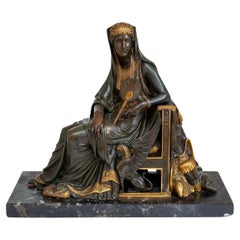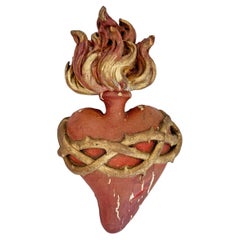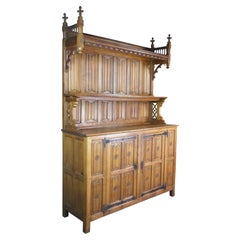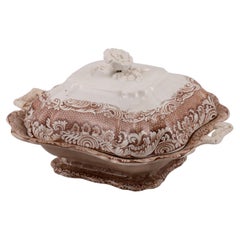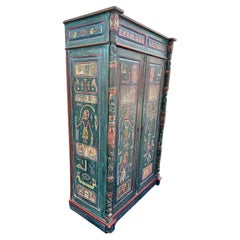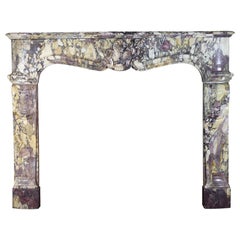Revival Furniture
to
410
1,407
1,392
2,919
12,445
5,469
4,413
3,295
3,212
3,002
2,990
1,740
1,694
1,548
1,209
874
434
319
275
162
103
134
2,919
3,018
613
1,126
928
453
189
43
138
90
105
159
131
160
70
53
1,501
1,195
547
469
357
2,573
1,005
519
463
410
2,919
2,919
2,919
21
13
10
10
10
Style: Revival
Period: 19th Century
French "Cleopatra" Patinated Bronze, 19th C.
Located in Astoria, NY
French "Cleopatra" Patinated and Gilt Bronze Sculpture, late 19th century, Egyptianesque, the seated queen holding a fan, on a Portoro marble plinth. 12.5" H x 14.5" W x 6" D.
Category
Late 19th Century French Antique Revival Furniture
Materials
Marble, Bronze
Hand Carved Wooden Sacred Heart With Red And Gilt Over Gesso 1889
Located in Hastings, GB
This beautiful Sacred Heart Sculpture dates to 1889 and would originally have hung near the altar in a German Church. The heart is crafted from wood with a gesso covering and hand pa...
Category
1880s German Antique Revival Furniture
Materials
Gesso, Wood
Antique French Gothic Revival Vaisselier Bar Cupboard Sideboard Hutch Linen Fold
Located in Dayton, OH
Monumental antique French Gothic Revival Vaisselier, bar back, server, buffet, sideboard or cupboard. Made of oak featuring paneled linen...
Category
19th Century Antique Revival Furniture
Materials
Oak
$5,520 Sale Price
38% Off
Vegetable bowl with lid, Morro Castle, Havana, Cuba. Sargadelos, 19th cent.
By Sargadelos
Located in Madrid, ES
Vegetable bowl with lid, Morro Castle, Havana, Cuba. Earthenware. Sargadelos, 19th century.
It has minor flaws.
Vegetable bowl with handles and a lid on which a landscape can be se...
Category
19th Century Spanish Antique Revival Furniture
Materials
Other
19th Century Hand Carved Painted Egyptian Turquoise Green Wardrobe
Located in Fort Lauderdale, FL
Transport yourself back to the sleek and sophisticated 19th Century with this exquisite hand crafted, sculpted and painted wardrobe storage cabinet. The ultra rare wardrobe gives an ...
Category
Late 19th Century Egyptian Antique Revival Furniture
Materials
Wood, Paint
19th Century Parisian Breche Violet Marble Fireplace Surround For Luxury Living
Located in Beervelde, BE
Fabulous, rich in color, Royal Brêche Violet Marble chimney piece. It is a exceptional Regency style, 19th century. Unique historic fireplace mantel for a signature interior. This or...
Category
19th Century French Antique Revival Furniture
Materials
Marble, Breccia Marble
Antique French Victorian Neo-Renaissance Gilt Brass Andirons & Fender Bar Set
Located in Forney, TX
A most impressive 19th century French gilt bronze three-piece fireplace set.
France, circa 1870, almost certainly Parisian work, exceptionally executed in Renaissance Revival taste,...
Category
19th Century French Antique Revival Furniture
Materials
Brass, Bronze, Iron
Antique European Mechelen Renaissance Oak Hunt Display Cabinet Stained Glass 90"
Located in Dayton, OH
Monumental Antique Mechelen Renaissance Revival China Hutch, circa 1890s. Made from oak with elaborate figural and floral carved details. Features vibrant original stained glass w...
Category
1890s European Antique Revival Furniture
Materials
Brass
$4,680 Sale Price
20% Off
Renaissance Revival Oak Credenza/Sideboard From the Late 19th Century
Located in Opole, PL
Renaissance Revival Oak Credenza/Sideboard from the Late 19th Century
A massive oak credenza/sideboard in the Neo-Renaissance style, dated to Q4 of the 19th century. The base of the...
Category
Late 19th Century European Antique Revival Furniture
Materials
Oak
$2,312 Sale Price
20% Off
Cupid, Glazed Porcelain, Etc. Possibly Meissen, 19th Century
Located in Madrid, ES
Cupid. Glazed porcelain, etc. Possibly Meissen, 19th century.
With sticker on the base. It presents restorations.
Porcelain figurine that presents an oval and golden base on which Cupid is reclining, characterized as usual by his wings, his bow and his quiver with arrows. In addition, he carries a torch and appears with a garland of leaves. The piece presents strong similarities with figures found in clocks from Meissen, dating from the 19th century. VL Veneziani was a shop headquartered on Rome's Via Frattina (and another store on Via Gregoriana) specializing in selling antique...
Category
19th Century European Antique Revival Furniture
Materials
Other
19th Century French Renaissance Hand-Carved Giltwood Mirror
Located in Dallas, TX
19th century French Renaissance hand-carved giltwood mirror was carved in the Italian style from solid wood, then gilded for an opulent effect. The entire frame consists of shell, fo...
Category
Late 19th Century French Antique Revival Furniture
Materials
Giltwood
Procession banner with Maria and Child
Located in 'S-HERTOGENBOSCH, NL
Procession banner from the German pilgrimage site Kevelaar (near the Dutch boarder). The banner, in blue, red and beige silk with brocade, hangs from a wood carved and gilded pendant...
Category
1880s German Antique Revival Furniture
Materials
Brocade, Canvas, Silk, Giltwood
19th Century French Colonial Cabinet with Mother of Pearl
Located in San Marino, CA
19th century French colonial cabinet with mother-of-pearl inlay along all panels. Hexagonal mosaic along door trim, with floral and butterfly motif throughou...
Category
19th Century Vietnamese Antique Revival Furniture
Antique Gothic Revival Carved Oak Stair Rail Newel Post w Angel Sculpture 19thC.
Located in Lisse, NL
Unique and top quality carved stair newel post from the 1800s.
If you are looking to upgrade the style and quality of your home interior then this fabulou...
Category
Mid-19th Century German Antique Revival Furniture
Materials
Oak
19th Century Dutch Baroque Style Lacquered Mirror
Located in Madrid, ES
Late 19th century dark brown lacquered mirror, molded and stepped borders, in Baroque style.
Category
Late 19th Century Dutch Antique Revival Furniture
Materials
Beech
$2,119 Sale Price
20% Off
Second Empire Gothic Cathedral Clock and Garniture
By Pierre-François Feuchère
Located in Vancouver, British Columbia
A mid 19 century French Gilt Bronze Gothic style mantel clock and garniture which the French call " A la Cathedrale". The three pieces are of finely chased and gilded bronze; the cl...
Category
Mid-19th Century French Antique Revival Furniture
Materials
Bronze
Neo-gothic cabinet in oak with rich decorations and hidden storage, France, 1850
Located in Meulebeke, BE
France / 1850 / cabinet / oak / neo-gothic / antique
Oak neo-gothic cabinet/ highboard with 2 doors and 2 large drawers with beautiful original brass hardware, hand crafted in Franc...
Category
1850s French Antique Revival Furniture
Materials
Wood, Oak
Antique French SET OF 8 Dining Chairs Upholstered Carved Walnut 19thC EXQUISITE
Located in Tyler, TX
STUNNING Antique French SET OF 8 Renaissance Revival Walnut Upholstered Exquisitely Carved Dining Chairs~~c. 1880s
SUPERB French style~~STATELY set with highly carved angels and che...
Category
1880s French Antique Revival Furniture
Materials
Walnut
19th Century Victorian Gothic Revival Ecclesiastical Altar Table Attrib Pugin
Located in Forney, TX
A rare grand Victorian Gothic religious church altar attributed to A.W.N Pugin (1812-1852)
Hand-crafted of solid pine in the first half of the 19th century, having a removable octagonal top over conforming architectural well-form pedestal base with heavy-duty braced open interior, arched molding...
Category
19th Century English Antique Revival Furniture
Materials
Wood, Pine
19th Century Copeland Spode Greek Tazza
Located in Fort Lauderdale, FL
A brightly colored Neoclassical tazza or cake plate in the 'Greek' pattern made by Copeland Spode in the late 19th century.
This tazza, in Copeland Spode’s ‘Greek...
Category
Late 19th Century British Antique Revival Furniture
Materials
Earthenware, Pearlware
19th Century Italian Painting of The Virgin of the Fish
Located in Scottsdale, AZ
19th Century Italian Painting of The Virgin of the Fish done in the Purisimo Style. Revivalist piece of a Raphael Painting. The Virgin Mary & baby Jesus with Saint Jerome and Arc Angel...
Category
19th Century French Antique Revival Furniture
Materials
Giltwood, Paint
Gothic Revival Two Pieces Hunt Cabinet
Located in North Hollywood, CA
Stunning Gothic Revival oak cabinet. The carved saints at the upper corners, ogee arch shape of the glass panes on the upper doors and in the carvings on the lower doors, the quarter...
Category
Early 1800s French Antique Revival Furniture
Materials
Metal
Antique 19th Century Large Gilt and Marble Hall Console Table – Fine Quality
Located in Wisbech, Cambridgeshire
Antique 19th Century Large Gilt and Marble Hall Console Table – Fine Quality.
The table has a lovely age, colour and patina. The finishes are original, with losses and touching up. ...
Category
19th Century Antique Revival Furniture
Materials
Marble
$3,372 Sale Price
30% Off
A Monumental Renaissance Revival Clock Garniture, Attributed to Feuchère
Located in Brighton, West Sussex
A Large and Important Louis Philippe Period Gilt-Bronze Three-Piece Clock Garniture.
Attributed to the Feuchère family. The clock movement by Hémon.
In the Renaissance revival style. Comprising a clock and a pair of nine-light candelabra. The clock case of architectural out-shape with cherubic term figures supporting a rectangular pediment centred by an urn. The sides of the clock tower cast in relief with strapwork and foliage. The dial inset with enamel Roman numeral chapters. The twin-barrel clock movement with tic-tac escapement, silk suspension and countwheel strike to bell. Pendulum and winding key.
The candelabra as twin-handled vases supporting tiered branches with candle nozzles. Modelled en suite with naturalistic scrolls and foliage. Surmounted by finials modelled as an eagle toying with a serpent. The scrolled handles flanked by cherubic figures and serpents. The bodies fronted by bacchic masks and supported on socles bearing angels.
France, Circa 1835.
The clock movement signed ‘HEMON A PARIS’. The clockmaker Claude Hémon was established at rue de St. Martin circa 1810-1820.
Dimensions, the clock:
Height : 106 cm 42 inches
Width : 58 cm 23 inches
Depth : 38 cm 15 inches
Weight : 72 kg
Dimensions, the candelabra:
Height : 104 cm 41 inches
Width : 36 cm 14 inches
Depth : 36 cm 14 inches
Weight : 28 kg (each)
This magnificent clock garniture of palatial size is designed in the Renaissance revival style and dates to the Louis Philippe period. Executed in sculptural gilt-bronze with leaves, scrolls, masks and exotic birds, the naturalistic ornament represents an elaborate system of allegories and mythological iconography which recall the influence of Italian Mannerist art in France.
The distinctive design reflects a new style which replaced the neoclassism of the French Empire period. With the fall of Napoleon Bonaparte, artists and designers sought a new decorative vocabulary with which to aggrandise the Bourbon restoration. With the French revolution and Louis XVI’s execution still within living memory, it seemed too soon for a revival of the style of the Grand Siècle. Instead they looked further back to the time of François I, whose patronage of Italian artists had brought the Renaissance to France. The idea of a renaissance revival appealed to the new Bourbon monarchs and their patronage ignited great creativity in the arts.
The reigns of Louis XVIII and Charles X, who were brothers of the late King, Louis XVI, and later of Louis Philippe I, nicknamed the Citizen King, coincided with the enlightenment and the dawn of the industrial age. Great technical progress was made in metallurgy and casting which raised the art of bronze making to new heights in the hands of great masters such as Pierre-Philippe Thomire (1751-1843) and Pierre- Jean-François Denière (1774-1866).
The renaissance provided a rich and varied source book in architecture, furniture and other decorative arts for designers such as Claude Aimé Chenavard (1798-1838) whose Album de l’ornemaniste (1835) became a reference work. Léon Feuchère (1804-1857) also produced drawings of interiors, silver, bronzes and furniture and was a scion of the prominent family of bronze castors established by his grandfather Pierre-François Feuchère (1737-1823) who had worked as a gilder for the bronze caster Pierre Gouthière before setting up a bronze foundry that would become one of the largest in Paris under the management of his son Lucien-François (d. 1841) and grand-son Armand (1797-1866). A number of drawings by Léon Feuchère have recently been discovered by the Rijksmuseum and probably belonged to the collection of Louis-Philippe-Albert, duc d’Orléans, comte de Paris (1838-1894). Louis-Philippe-Albert was the grandson of the French king, Louis-Philippe I (1773-1850), who granted him the title of comte de Paris, and the son of Ferdinand-Philippe, duc d’Orléans (1810-1842). Ferdinand-Philippe was an important collector and sponsored many young artists to create metalwork objets d’art, notably a celebrated surtout de table made by Claude-Aimé Chenavard and Jean-Jacques Feuchère (1807-1852), a cousin of Armand and Léon. Principally remembered as a sculptor, Jean-Jacques Feuchère trained in the family foundry and designed small objects, cigar boxes...
Category
Early 19th Century French Antique Revival Furniture
Materials
Bronze
Pair of 19th Century French Empire Porphyry and Gilt Bronze Lamps
Located in Larkspur, CA
Pair of beautiful 19th century French Porphyry lamps with gilt bronze accents in the form of Ram's heads and Classical beaded banding. The pair are mounted on a gold leafed stepped b...
Category
1880s French Antique Revival Furniture
Materials
Porphyry
A high Gothic Revival oak armchair with carved and fretwork sides
Located in London, GB
Walford & Donkin. A high Gothic Revival oak armchair with carved and fretwork sides for The Art Furniture Company who were an architectural interior and furniture design partnership at 25 Garrick Street.
Seat height: 42.5 cm
Arm height: 62 cm
The Illustrated London News on the 17th June 1867 wrote:, The Art Furniture Company was 'prepared to supply at ordinary trade prices, domestic furniture of an artistic and picturesque character, designs by C L Eastlake, A W Blomfield, and E W Godwin and other architects'. Eastlake's Hints on Household Taste of 1868 featured a cabinet designed by him and exhibited by Heaton, Butler & Bayne but probably made by the Art Furniture Co. Godwin designed 16 pieces of furniture for the firm in Japanese and Gothic Revival styles. His Anglo-Japanese buffet (illus. Soros (1999), CR 304-a) was executed by AFC as were some of his Gothic revival chairs for Dromore Castle, including the eagle chair...
Category
1860s Antique Revival Furniture
Materials
Oak
Shop Counter Sarreguemines Porcelain
Located in Vosselaar, BE
This late 19th century French shop counter is extremely rare because of its custom made Sarreguemines porcelain panels. Every panel is a bit different and fits seamlessly with bolts ...
Category
19th Century French Antique Revival Furniture
Materials
Wood
Set of Six 19th C. Renaissance Revival Dining chairs
Located in Los Angeles, CA
This striking set of six 19th century French dining chairs showcases the ornate craftsmanship of the Renaissance Revival style. Each chair features intricately hand-carved walnut fra...
Category
19th Century French Antique Revival Furniture
Materials
Leather, Oak
$4,416 Sale Price / set
20% Off
19th Century French Henri II Oak Hall Tree ~ Coat Rack
Located in Dallas, TX
19th Century French Henri II Oak Hall Tree ~ Coat Rack makes a great choice in any entryway, providing a convenient place to hang one's hat, coat, and park an umbrella, or even a wal...
Category
Late 19th Century French Antique Revival Furniture
Materials
Steel
Pr, French Empire Revival Patinated & Gilt-Bronze Vases by Fumière et Cie, Paris
Located in Atlanta, GA
Pair of French Empire Revival Patinated and Gilt-Bronze Vases by Fumière et Cie, Paris
Stamped “FUMIÈRE / TRIBAUT / SUCCr / 12 RUE DE L'ÉCHAUDÉ / PARIS”
France, late 19th to early 20...
Category
Late 19th Century French Antique Revival Furniture
Materials
Bronze
19th Century French Gothic Revival Carved Bleached Oak Hall Bench with Trapdoor
Located in Dallas, TX
Compliment your entryway, hallway or mud room with this heavily carved antique bench. Crafted in northern France, circa 1880, and built of solid oak wood, the bleached Renaissance st...
Category
Late 19th Century French Antique Revival Furniture
Materials
Oak
American Gothic Revival Pine Wood Plant Stand Table
Located in Southampton, NJ
This 19th-century American Gothic Revival table is a breathtaking example of the period's craftsmanship and design sensibilities. Carved from solid pine wood, it embodies the intrica...
Category
19th Century American Antique Revival Furniture
Materials
Pine
Large Antique French Bench Settee Gothic Oak Tracery Lift Top Seat c. 19th
Located in Tyler, TX
BEAUTIFUL Antique French Oak GOTHIC REVIVAL Bench, Settee or Church Pew with Lift-Top Seat for Storage~~HIGHLY CARVED ~~c.
1890s
Spectacular design elements featuring lin...
Category
Late 19th Century French Antique Revival Furniture
Materials
Oak
19th Spanish Low Console Table with Solomonic Legs & Two Carved Drawers
Located in Miami, FL
This large Spanish late 19th century features a beautiful one plank rectangular top over two carved drawers. Each drawer, featuring slightly different hardware, is adorned with geome...
Category
Late 19th Century Spanish Antique Revival Furniture
Materials
Iron
$3,980 Sale Price
20% Off
Antique Second Empire French Doré Gilt Bronze Vases or Urns
Located in Philadelphia, PA
A fine pair of antique French gilt bronze vases.
Decorated with an assembly of musical instruments, a gourd, and even a hat.
Extremely solid and finely cast, these urns or vas...
Category
Late 19th Century French Antique Revival Furniture
Materials
Bronze
Pair of 19th Century French "Portier" Tapestries ( 3'9" x 10'4" - 114 x 315 )
Located in New York, NY
Pair of 19th Century French "Portier" Tapestries ( 3'9" x 10'4" - 114 x 315 )
Category
1890s French Antique Revival Furniture
Materials
Wool
Egyptian Revival Grande Sonnerie Clock from the Biedermeier Period
Located in Hamilton, Ontario
Egyptian Revival Grande Sonnerie clock from the Biedermeier period. It features animated workmen that swing an anvil, pump bellows while making a 'clac...
Category
19th Century Antique Revival Furniture
Pair Antique Roman Neoclassical Patinated Bronze Vases
Located in New York, NY
Pair of antique patinated bronze vases with variegated green marble pedestals in the Roman neoclassical style featuring finely cast figur...
Category
Late 19th Century Antique Revival Furniture
Materials
Bronze
Richly Carved Baroque Revival Italian Picture Frame with Scrolling Leaves & Vase
Located in Lisse, NL
Stunning antique picture or photograph wall picture frame from the mid 1800's.
This stylish and all handcrafted picture frame will make great decoration on your wall and with a work...
Category
Mid-19th Century Italian Antique Revival Furniture
Materials
Wood
19th Century Renaissance Revival Style Britannia Silver Plated WMF Beer-Tankard
Located in Los Angeles, CA
A Fine and Elaborate German 19th Century Renaissance Revival Style Britannia Silver Plated Beer-Tankard by The Württembergische Metallwarenfabrik (WMF). T...
Category
Late 19th Century German Antique Revival Furniture
Materials
Silver Plate
$5,160 Sale Price
20% Off
19th Century Antwerp Merchant House Marble Fireplace Mantel
Located in Beervelde, BE
This is a beautiful and historically rich marble fireplace mantel. From its 19th-century origins and being reclaimed from an Antwerp merchant house, it holds a story of elegance and ...
Category
19th Century Belgian Antique Revival Furniture
Materials
Marble
Antique French Console Side Table Renaissance PETITE Gothic Carved Oak c1880
Located in Shreveport, LA
Antique French Console Side Table Renaissance PETITE Gothic Carved Oak c1880.
Direct from France, a very elegant, and quite petite, antique French carved console or side table!
Incr...
Category
Late 19th Century French Antique Revival Furniture
Materials
Oak
Antique French Louis Revival Marble & Ormolu Occasional Table 19th Century
Located in London, GB
This is a beautiful antique French Louis Revival circular centre table with ornate ormolu decoration typical of the Louis XIV period, circa 1870 in date.
The inset marble top has a ...
Category
1870s Antique Revival Furniture
Materials
Ormolu
Gothic Revival oak display cabinet with arch & quatrefoil decoration on a stand.
Located in London, GB
A Gothic Revival oak display cabinet with an open display area to the top and little ear shaped details to each side and a castellated decoration below the glazed door, with five arc...
Category
1870s English Antique Revival Furniture
Materials
Oak
19th Century Catalan Spanish Carved Walnut Console Sofa Table, Four Drawers
Located in Miami, FL
19th century Spanish antique walnut chest of four drawers and original iron hardware.
You can use like a commode or chest of drawers or large nightstand.
This elegant console was cra...
Category
Late 19th Century Spanish Antique Revival Furniture
Materials
Iron
Italian School Painting of Madonna and Child
Located in Woodbury, CT
19th century Italian School oil on canvas of Madonna and child. Gilt frame.
Category
19th Century Italian Antique Revival Furniture
Materials
Canvas
Antique chest of drawers, around 1880, Western Europe.
Located in Chorzów, PL
Antique chest of drawers from around 1880, Western Europe.
Furniture in very good condition, after professional renovation.
Dimensions: height 95 cm / width 164 cm / depth 65 cm
Category
Late 19th Century Unknown Antique Revival Furniture
Materials
Wood, Oak
Antique Sienna Marble Fireplace in the Rococo Revival Style
Located in Tyrone, Northern Ireland
A most stunning Sienna marble chimneypiece in the Rococo Revival style.
A large shell cartouche is flanked by scrolled foliage on raised and fielded panels. The angled cabriole jamb...
Category
1830s British Antique Revival Furniture
Materials
Siena Marble
Antique Italian Renaissance Revival Carved Tufted Tete-A-Tete Bench
Located in Chicago, IL
Antique Italian Renaissance Revival Carved Ornate Figural Walnut Button Tufted Tete-a-Tete Parlor Bench Newly Upholstered in Italian Full Grain Distressed...
Category
Late 19th Century Unknown Antique Revival Furniture
Materials
Leather, Wood
19th Century French Renaissance Hunt Vaisselier Buffet
Located in Dallas, TX
19th Century French Renaissance Hunt Vaisselier Buffet was artistically sculpted to celebrate the bounty of the earth, and perform a display, serving...
Category
1850s French Antique Revival Furniture
Materials
Oak
Carved chest of drawers, France, circa 1840.
Located in Chorzów, PL
An old, narrow chest of drawers in the Renaissance style. Made in the mid-19th century from oak wood. The piece of furniture is unique, richly decorated with carvings in the form of ...
Category
1840s French Antique Revival Furniture
Materials
Oak
Large & Stunning Antique Fine Bronze Gothic Revival 12 Light Chandelier Pendant
Located in Lisse, NL
Handcrafted and truly beautiful Gothic chandelier for candles.
In antiques it often is the case that the older a piece is, the better the quali...
Category
19th Century French Antique Revival Furniture
Materials
Brass, Bronze
German 19th Century Oil on Canvas Triptych of Cherubs by Ferdinand Wagner II
Located in Los Angeles, CA
Ferdinand Wagner II (German, 1847-1927) A very fine and charming triptych group of three oil on canvas laid on board titled "An Allegory to Spring" each panel depicting different playful and joyous scenes of putti and a cherubs reminiscent of spring, love and peace. The center panel depicting a seated putto, crowned with flowers, a standing putto behind him holding a sack of arrows and a seated cherub facing him next to a watchful peace dove on top resting of a flower bouquet. The left panel depicting a seated putto next to a standing putto with a freshly harvested apple. The right side panel depicting a standing cherub holding a fig branches with leaves. All three-in-one panels within individually carved giltwood frames. All panels signed at the lower left: Ferd. Wagner, circa 1890.
Ferdinand Wagner II (German, 1847-1927) was the son of Passau Ferdinand Wagner Senior, a teacher at a vocational art school who began training him professionally at a young age. After traveling to Italy in 1867-1868, he continued with his art studies at The Munich Academy of Arts led by Peter Von Cornelius and Julius Schnorr...
Category
Late 19th Century German Antique Revival Furniture
Materials
Canvas, Wood
French Carved Gothic Revival Oak & Leather Chair Ca 19th Century
Located in Bonita Springs, FL
19th-Century French Gothic Revival Hall Chair
Steeped in history and artistry, this 19th-century French Gothic Revival hall chair is a true collector’s piece. Crafted from rich oak...
Category
19th Century French Antique Revival Furniture
Materials
Leather, Oak
1800's Antique Library, French, Carved Oak, Glazed Doors Bookcase!
Located in Austin, TX
Exceptional Antique Bookcase , Italian Renaissance Revival, Foliates, Late 19th Century, 1800s, 19th Century!!
This exquisite antique bookcase features exceptional craftsmanship and...
Category
19th Century Italian Antique Revival Furniture
Materials
Wood, Oak
$2,450 Sale Price
24% Off
Pair of 19th-Century Italian Polychrome and Parcel-Gilt Altar Prickets
Located in Rio De Janeiro, BR
Pair of 19th-Century Italian Polychrome and Parcel-Gilt Altar Prickets
A graceful pair of 19th-century Italian altar prickets, hand-carved in wood with their original polychrome and ...
Category
1880s Italian Antique Revival Furniture
Materials
Wood
Elegant Antique Empire Style Jardinière with Original Green Glass Liner
Located in Lisse, NL
Elegant Jardinière with original glass liner, brass bonbonnière for caviar, chocolates, or floral display.
Striking and rare Empire-style jardinière or bonbonnière, featuring an orn...
Category
19th Century French Antique Revival Furniture
Materials
Bronze, Brass
Antique Tuscan Walnut Cabinet with Inlays
Located in Milano, IT
Antique Tuscan furniture from the late 16th, early 17th century of fine Italian manufacture, with splendid mastery of woodwork.
The cabinet is...
Category
Early 1800s Italian Antique Revival Furniture
Materials
Wood
$3,371 Sale Price / item
20% Off
19th Century Renaissance Revival Desk Library Table
Located in Savannah, GA
Very ornately carved Renaissance Revival rich golden oak desk or library table with leather insert, that we believe to be original. Features include a ...
Category
1870s American Antique Revival Furniture
Materials
Leather, Oak
$2,295 Sale Price
58% Off
Bite, Panthers, Bronze, Marble, France, circa Late 19th Century, Masson
Located in Madrid, ES
Grip. Blued bronze, marble. France, towards the end of the 19th century.
Blued bronze sculpture on an oval marble base veined in green tones that shows two lionesses or two panther...
Category
Late 19th Century French Antique Revival Furniture
Materials
Marble, Bronze
Revival furniture for sale on 1stDibs.
Find a broad range of unique Revival furniture for sale on 1stDibs. Many of these items were first offered in the 21st Century and Contemporary, but contemporary artisans have continued to produce works inspired by this style. If you’re looking to add vintage furniture created in this style to your space, the works available on 1stDibs include decorative objects, lighting, tables and other home furnishings, frequently crafted with wood, metal and other materials. If you’re shopping for used Revival furniture made in a specific country, there are Europe, France, and Italy pieces for sale on 1stDibs. While there are many designers and brands associated with original furniture, popular names associated with this style include Ararat Rugs, Wedgwood, Woka Lamps, and Ferdinand Barbedienne. It’s true that these talented designers have at times inspired knockoffs, but our experienced specialists have partnered with only top vetted sellers to offer authentic pieces that come with a buyer protection guarantee. Prices for furniture differ depending upon multiple factors, including designer, materials, construction methods, condition and provenance. On 1stDibs, the price for these items starts at $30 and tops out at $721,205 while the average work can sell for $2,897.
Recently Viewed
View AllMore Ways To Browse
Cabinets With Metal Inlay
Cameo Glass Bowl
Campaign Chest Camphor
Canopic Jars
Canton Chinese Bowl
Cardinal Sculpture
Carrera Marble Dining Table
Carved Boar
Cast Grape Vine
Ceramic Cheetah
Ceramic Giraffe
Ceramic Pagoda
Ceramic Spanish Jug
Cherry Blossom Painting Japanese
Chest Of Drawers Display
Chinese Ancestral Portraits
Chinese Chippendale Style Display Cabinet
Chinese Coral Sculpture
